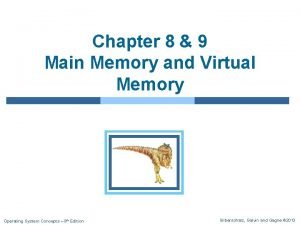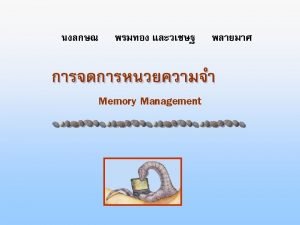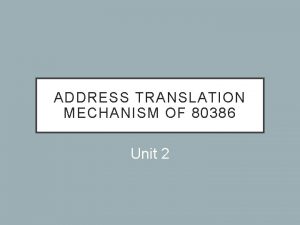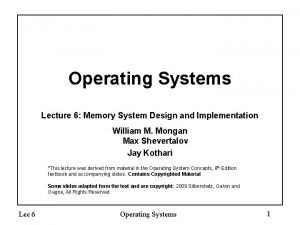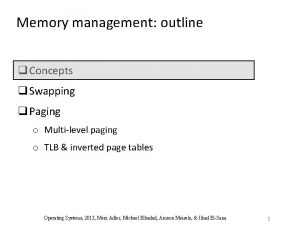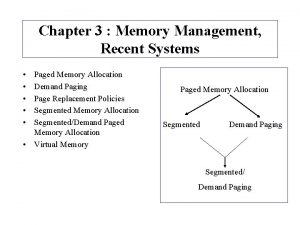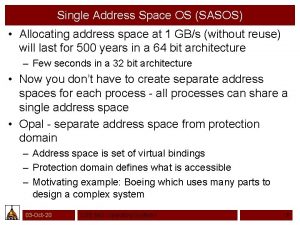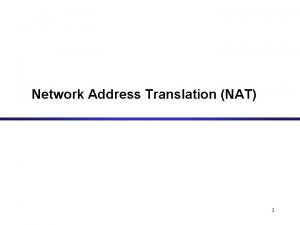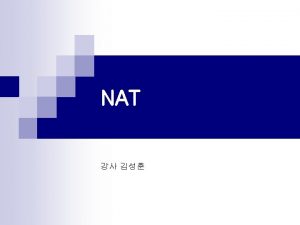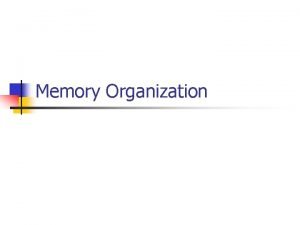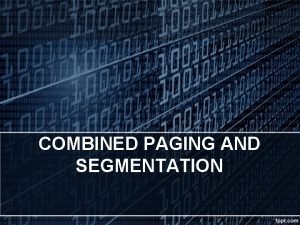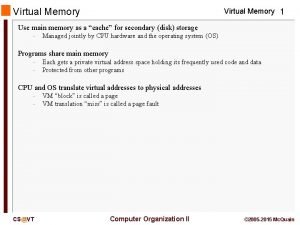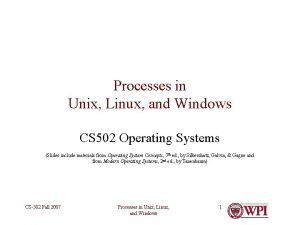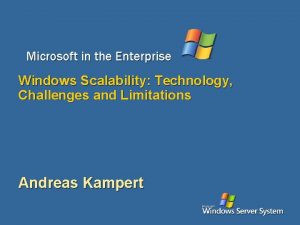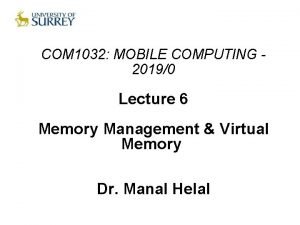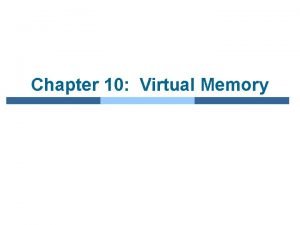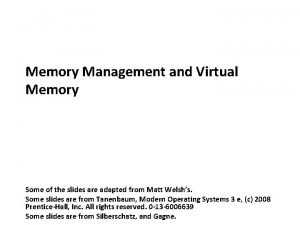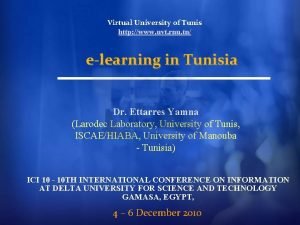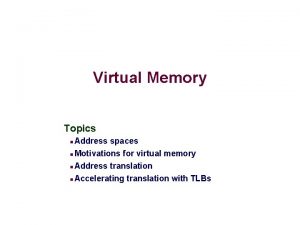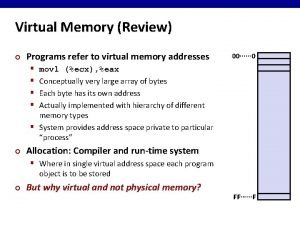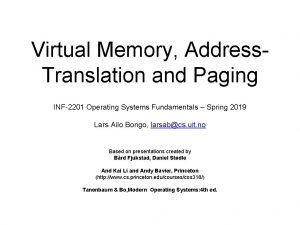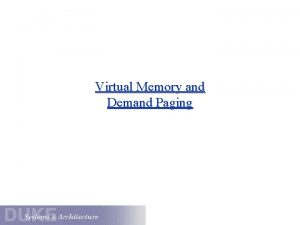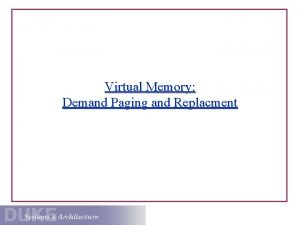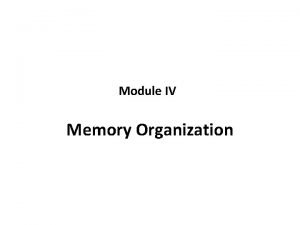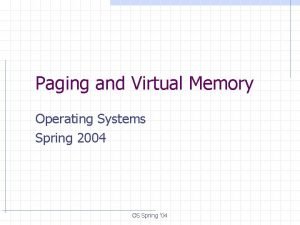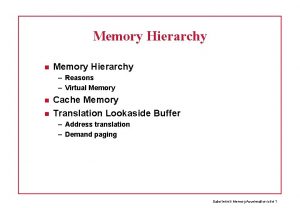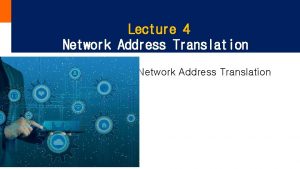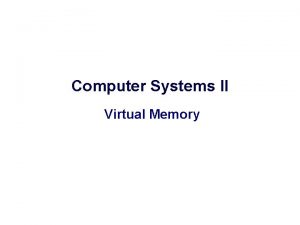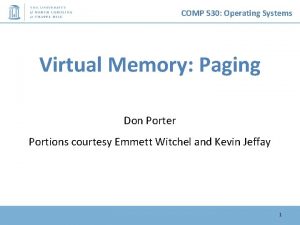Virtual Memory Address Translation and Paging INF2201 Operating







































- Slides: 39

Virtual Memory, Address. Translation and Paging INF-2201 Operating Systems – Spring 2017 Lars Ailo Bongo (larsab@cs. uit. no) … and based on presentations created by Lars Ailo Bongo, Tore Brox-Larsen, Bård Fjukstad, Daniel Stødle, Otto Anshus, Thomas Plagemann, Kai Li, Andy Bavier Tanenbaum & Bo, Modern Operating Systems: 4 th ed.

Overview • Part 1 • Virtual Memory • • • Virtualization Protection Address Translation • • Base and bound Segmentation Paging Translation look-ahead buffer • Part 2: Paging and replacement • Part 3: Design Issues 2 INF-2201 -2015, B. Fjukstad

Latency Numbers Every Programmer Should Know Latency Comparison Numbers -------------L 1 cache reference Branch mispredict L 2 cache reference Mutex lock/unlock Main memory reference Compress 1 K bytes with Zippy Send 1 K bytes over 1 Gbps network Read 4 K randomly from SSD* Read 1 MB sequentially from memory Round trip within same datacenter Read 1 MB sequentially from SSD* Disk seek Read 1 MB sequentially from disk Send packet CA->Netherlands->CA 0. 5 5 7 25 100 3, 000 10, 000 150, 000 250, 000 500, 000 1, 000 10, 000 20, 000 150, 000 ns ns ns ns 14 x L 1 cache 20 x L 2 cache, 200 x L 1 cache 0. 01 0. 15 0. 25 0. 5 1 10 20 150 ms ms 4 X memory 20 x datacenter roundtrip 80 x memory, 20 X SSD Notes ----1 ns = 10 -9 seconds 1 ms = 10 -3 seconds * Assuming ~1 GB/sec SSD Credit -----By Jeff Dean: http: //research. google. com/people/jeff/ Originally by Peter Norvig: http: //norvig. com/21 -days. html#answers Source: https: //gist. github. com/jboner/2841832 3 INF-2201 -2015, B. Fjukstad

The Big Picture • DRAM is fast, but relatively expensive • • Disk is inexpensive, but slow • • $25/GB 20 -30 ns latency 10 -80 GB’s/sec $0. 2 -1/GB (100 less expensive) 5 -10 ms latency (100 K times slower) 40 -80 MB/sec per disk (1, 000 times less) Our goals • • Run programs as efficiently as possible Make the system as safe as possible 4 INF-2201 -2015, B. Fjukstad

Issues • Many processes • • Address space size • • • The more processes a system can handle, the better Many small processes whose total size may exceed memory Even one process may exceed the physical memory size Protection • • A user process should not crash the system A user process should not do bad things to other processes 5 INF-2201 -2015, B. Fjukstad

No Memory Abstraction Figure 3 -1. Three simple ways of organizing memory with an operating system and one user process. Other possibilities also exist 6 Tanenbaum & Bo, Modern Operating Systems: 4 th ed. , (c) 2013 Prentice-Hall, Inc. All rights reserved.

A Simple System • Only physical memory • • Run three processes • • Applications use physical memory directly emacs, pine, gcc What if • • gcc has an address error? emacs writes at x 7050? pine needs to expand? emacs needs more memory than is on the machine? 7 INF-2201 -2015, B. Fjukstad

Protection Issues • Errors in one process should not affect others • For each process, check each load and store instruction to allow only legal memory references 8 INF-2201 -2015, B. Fjukstad

Expansion or Transparency Issue • A process should be able to run regardless of its physical location or the physical memory size • Give each process a large, static “fake” address space • As a process runs, relocate each load and store to its actual memory 9 INF-2201 -2015, B. Fjukstad

Virtual Memory • Flexible • • Simple • • Make applications very simple in terms of memory accesses Efficient • • • Processes can move in memory as they execute, partially in memory and partially on disk 20/80 rule: 20% of memory gets 80% of references Keep the 20% in physical memory Design issues • • • How is protection enforced? How are processes relocated? How is memory partitioned? 10 INF-2201 -2015, B. Fjukstad

Address Mapping and Granularity • Must have some “mapping” mechanism • • Mapping must have some granularity • • • Virtual addresses map to DRAM physical addresses or disk addresses Granularity determines flexibility Finer granularity requires more mapping information Extremes • • Any byte to any byte: mapping equals program size Map whole segments: larger segments problematic 11 INF-2201 -2015, B. Fjukstad

Generic Address Translation • Memory Management Unit (MMU) translates virtual address into physical address for each load and store • Software (privileged) controls the translation • CPU view • • Each process has its own memory space [0, high] • • Virtual addresses Address space Memory or I/O device view • Physical addresses 12 INF-2201 -2015, B. Fjukstad

Goals of Translation • Implicit translation for each memory reference • A hit should be very fast • Trigger an exception on a miss • Protected from user’s faults 13 INF-2201 -2015, B. Fjukstad

Base and Bound • Built in Cray-1 • Each process has a pair (base, bound) • Protection • • On a context switch • • Save/restore base, bound registers Pros • • A process can only access physical memory in [base, base+bound] Relocation possible Simple Flat and no paging Cons • • • Fragmentation Hard to share Difficult to use disks 14 INF-2201 -2015, B. Fjukstad

Segmentation • • • Each process has a table of (seg, size) Treats (seg, size) as a fine-grained (base, bound) Protection • • On a context switch • • Save/restore the table and a pointer to the table in kernel memory Pros • • • Each entry has (nil, read, write, exec) Efficient Easy to share Cons • • • Segments must be contiguous in physical memory Fragmentation within a segment Complex management 15 INF-2201 -2015, B. Fjukstad

Segmentation: Example Systems • Burroughs B 5000 • General Electrix GE-645 (Multics) • www. multicians. org • Intel i. APX 432 • IBM AS/400 • X 86 (limited) 16 INF-2201 -2015, B. Fjukstad

Paging • • Use a fixed size unit called page instead of segment Use a page table to translate • “Principle: Introducing (one level of) indirection” Various bits in each entry Context switch • • • What should page size be? Pros • • • Similar to segmentation Simple allocation Easy to share Cons • • Big table How to deal with holes? 17 INF-2201 -2015, B. Fjukstad

Paging (1) Figure 3 -8. The position and function of the MMU. Here the MMU is shown as being a part of the CPU chip because it commonly is nowadays. However, logically it could be a separate chip and was years ago. 18 Tanenbaum & Bo, Modern Operating Systems: 4 th ed. , (c) 2013 Prentice-Hall, Inc. All rights reserved.

Paging (2) Figure 3 -9. The relation between virtual addresses and physical memory addresses is given by the page table. Every page begins on a multiple of 4096 and ends 4095 addresses higher, so 4 K– 8 K really means 4096– 8191 and 8 K to 12 K means 8192– 12287 19 Tanenbaum & Bo, Modern Operating Systems: 4 th ed. , (c) 2013 Prentice-Hall, Inc. All rights reserved.

Paging (3) Figure 3 -10. The internal operation of the MMU with 16 4 -KB pages. 20 Tanenbaum & Bo, Modern Operating Systems: 4 th ed. , (c) 2013 Prentice-Hall, Inc. All rights reserved.

Structure of a Page Table Entry Figure 3 -11. A typical page table entry. 21 Tanenbaum & Bo, Modern Operating Systems: 4 th ed. , (c) 2013 Prentice-Hall, Inc. All rights reserved.

Speeding Up Paging Major issues faced: 1. The mapping from virtual address to physical address must be fast. 2. If the virtual address space is large, the page table will be large. Tanenbaum & Bo, Modern Operating Systems: 4 th ed. , (c) 2013 Prentice-Hall, Inc. All rights 22 reserved.

How Many PTEs Do We Need? • Assume 4 KB page • • Worst case for 32 -bit address machine • • • Equals “low order” 12 bits # of processes × 220 PTEs per page table (~4 Mbytes), but there might be 10 K processes. They won’t fit in memory together What about 64 -bit address machine? • • # of processes × 252 A page table cannot fit in a disk (252 PTEs = 16 PBytes)! 23 INF-2201 -2015, B. Fjukstad

Segmentation with Paging 24 INF-2201 -2015, B. Fjukstad

Multiple-Level Page Tables 25 INF-2201 -2015, B. Fjukstad

Inverted Page Tables • Main idea • • • Pros • • One PTE for each physical page frame Hash (Vpage, pid) to Ppage# Small page table for large address space Cons • • • Potential for poor cache performanceg Lookup is difficult Overhead of managing hash chains, etc 26 INF-2201 -2015, B. Fjukstad

Virtual-To-Physical Lookups • Programs only know virtual addresses • • Each virtual address must be translated • • • Each program or process starts from 0 to high address May involve walking through the hierarchical page table Since the page table stored in memory, a program memory access may requires several actual memory accesses Solution • Cache “active” part of page table in a very fast memory 27 INF-2201 -2015, B. Fjukstad

Translation Look-aside Buffer (TLB) 29 INF-2201 -2015, B. Fjukstad

Bits in a TLB Entry • Common (necessary) bits • • • Virtual page number: match with the virtual address Physical page number: translated address Valid Access bits: kernel and user (nil, read, write) Optional (useful) bits • • Process tag Reference Modify Cacheable 30 INF-2201 -2015, B. Fjukstad

Hardware-Controlled TLB • On a TLB miss • Hardware loads the PTE into the TLB • • • Write back and replace an entry if there is no free entry Generate a fault if the page containing the PTE is invalid VM software performs fault handling Restart the CPU On a TLB hit, hardware checks the valid bit • • If valid, pointer to page frame in memory If invalid, the hardware generates a page fault • • Perform page fault handling Restart the faulting instruction 31 INF-2201 -2015, B. Fjukstad

Software-Controlled TLB • On a miss in TLB • • • Write back if there is no free entry Check if the page containing the PTE is in memory If not, perform page fault handling Load the PTE into the TLB Restart the faulting instruction On a hit in TLB, the hardware checks valid bit • • If valid, pointer to page frame in memory If invalid, the hardware generates a page fault • • Perform page fault handling Restart the faulting instruction 32 INF-2201 -2015, B. Fjukstad

Hardware vs. Software Controlled • Hardware approach • • Efficient Inflexible Need more space for page table Software approach • • Flexible Software can do mappings by hashing • • • PP# → (Pid, VP#) → PP# Can deal with large virtual address space 33 INF-2201 -2015, B. Fjukstad

Caches and TLBs • Both may be single- or multiple level • Both may be unified or split • Both may offer different levels of associativit 34 INF-2201 -2015, B. Fjukstad

Cache vs. TLB 35 INF-2201 -2015, B. Fjukstad

Detour: Accosiativity http: //en. wikipedia. org/wiki/File: Cache, associative-fill-both. png 36 INF-2201 -2015, B. Fjukstad

www. cs. hmc. edu/~geoff/classes/. . . /class 14_vm 1. ppt 37 INF-2201 -2015, B. Fjukstad

TLB Related Issues • What TLB entry to be replaced? • • • What happens on a context switch? • • • Random Pseudo LRU Process tag: change TLB registers and process register No process tag: Invalidate the entire TLB contents What happens when changing a page table entry? • • Change the entry in memory Invalidate the TLB entry 38 INF-2201 -2015, B. Fjukstad

Consistency Issues • “Snoopy” cache protocols (hardware) • • Consistency between DRAM and TLBs (software) • • Maintain consistency with DRAM, even when DMA happens You need to flush related TLBs whenever changing a page table entry in memory TLB “shoot-down” • On multiprocessors, when you modify a page table entry, you need to flush all related TLB entries on all processors, why? 39 INF-2201 -2015, B. Fjukstad

Summary – Part 1 • Virtual Memory • • • Address translation • • • Virtualization makes software development easier and enables memory resource utilization better Separate address spaces provide protection and isolate faults Base and bound: very simple but limited Segmentation: useful but complex Paging • • TLB: fast translation for paging VM needs to take care of TLB consistency issues 40 INF-2201 -2015, B. Fjukstad
 Virtual memory address translation
Virtual memory address translation Virtual memory meaning
Virtual memory meaning Virtual memory in os
Virtual memory in os Single partition allocation
Single partition allocation Demand paging in virtual memory
Demand paging in virtual memory Virtual memory demand paging
Virtual memory demand paging Page translation in 80386
Page translation in 80386 Page fault
Page fault Paging in operating system
Paging in operating system Q concepts
Q concepts Demand paged memory allocation
Demand paged memory allocation Virtual memory in memory hierarchy consists of
Virtual memory in memory hierarchy consists of Physical address vs logical address
Physical address vs logical address Sasos
Sasos Single address space
Single address space Comunicative translation
Comunicative translation Parent transformations
Parent transformations Migrate network address translation
Migrate network address translation Network address translation test
Network address translation test Memory address in hexadecimal
Memory address in hexadecimal Microprogram sequencer for a control memory
Microprogram sequencer for a control memory In segmentation each address is specified by
In segmentation each address is specified by Internal memory and external memory
Internal memory and external memory Primary memory and secondary memory
Primary memory and secondary memory Internal fragmentation
Internal fragmentation Virtual address space
Virtual address space Virtual memory
Virtual memory Windows virtual address space
Windows virtual address space Windows virtual address space
Windows virtual address space Mapuserphysicalpages
Mapuserphysicalpages Windows virtual address space
Windows virtual address space Shared pages
Shared pages Virtual memory linux
Virtual memory linux Uvt tunis
Uvt tunis Gdtr
Gdtr Virtual address
Virtual address Virtual address
Virtual address Has virtual functions and accessible non-virtual destructor
Has virtual functions and accessible non-virtual destructor Voice translation profile
Voice translation profile Semantic translation và communicative translation
Semantic translation và communicative translation




